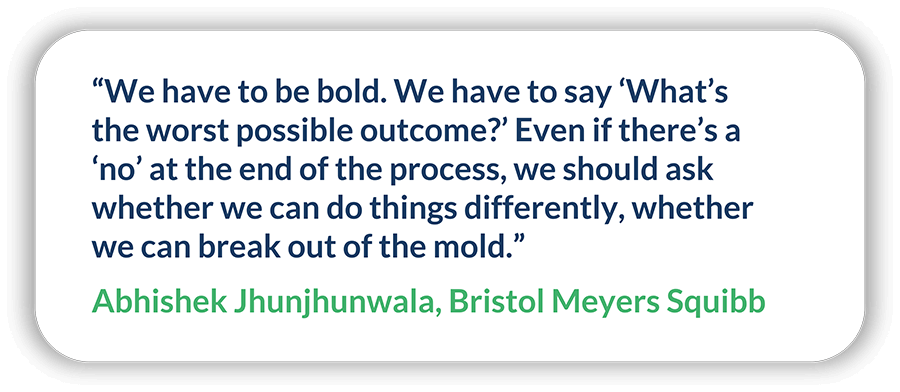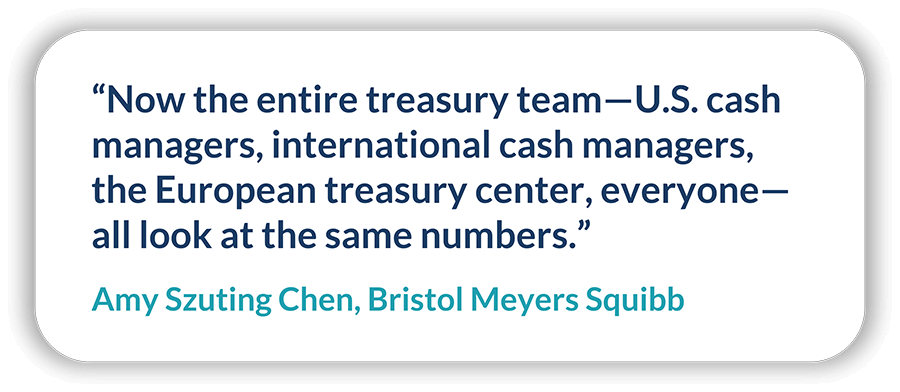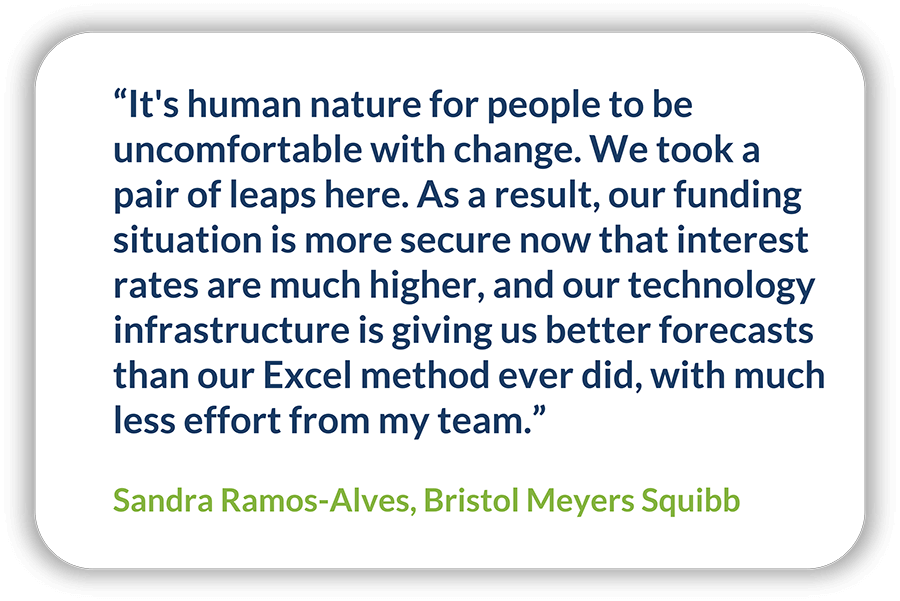And the winner of the 2024 Gold Alexander Hamilton Award in Liquidity Management is … Bristol Myers Squibb. Congratulations!
Note: This article was originally published by Treasury & Risk Editor in Chief Meg Waters, based on her interview with the treasury team at Bristol Meyers Squibb. You can view her original article here: Biopharmaceutical Giant Breaks out of the Cash Forecasting Mold (treasuryandrisk.com).
Interview Participants
- Amy Szuting Chen, Director of International Treasury, Bristol Meyers Squibb
- Sandra Ramos-Alves, SVP & Treasurer, Bristol Meyers Squibb
- Abhishek Jhunjhunwala, Director of Capital Markets, Bristol Meyers Squibb
The corporate treasury team at global biopharmaceutical company Bristol Myers Squibb manages cash and cash equivalents in the billions of dollars (US$11.5 billion as of December 31, 2023) across more than 200 legal entities around the world. Efficient cash forecasting in this environment requires clear visibility into global accounts and as much automation as possible. Until recently, the forecasting process provided treasury with visibility into 99 percent of the company’s accounts—but it was manual and cumbersome.
“We take two approaches to cash forecasting,” explains Amy Szuting Chen, director of international treasury. “Treasury prepares a top-down, P&L [profit and loss]–driven multiyear forecast and a bottom-up forecast based on receipts and disbursements for the current year. For the bottom-up forecast, in each budget cycle—so, four times per year—treasury would collect data from our business partners, line by line. We would gather gross sales projections, as well as spending and payments, such as operating expenses and capex [capital expenditures] at the legal-entity level.
“The information for a standard bottom-up cash forecast was submitted by different teams, and not in a standard format,” Chen continues. “Each business views their forecast differently, and there are variations in their methodologies. So the treasury team would have to consolidate all this data in Excel, which created a lot of manual work and took a month or more each quarter.”
International business units added another layer of complexity because different geographic regions handled forecasting differently. “Internationally, we had three different forecasts that were not 100 percent in sync with each other,” Chen says. “Occasionally, one forecast might show a cash surplus, while another forecast for the same region might show a net outflow using a different set of assumptions.” The forecast timelines also varied. Whereas corporate treasury generated daily forecasts for the U.S. market, the international team worked with business units to predict monthly cash receipts and disbursements.
“We are operating in a dynamic environment as a company right now, and we are required to make a lot of business decisions quickly,” says Abhishek Jhunjhunwala, director of capital markets. “On the capital markets side, we work on many scenarios around different capital allocation strategies, and cash is a critical component. When we had a manual process to pull together forecasting information, it certainly created a decision-making hurdle. We would all have to wait for the top-down and bottom-up forecasts to be generated and then reconciled, which slowed down our decision-making.
“Bristol Myers Squibb has engaged in a lot of M&A [merger and acquisition] activity recently, and every transaction requires cash,” he adds. “A couple of years ago, we were considering whether we had the capital to complete a certain acquisition, what our cash flows would look like, and whether we needed more support from a liquidity perspective. We had the P&L forecast, but the final cash flow forecast was not immediately available.”
Bristol Myers Squibb treasury needed to standardize and accelerate global cash forecasting, shifting toward automation wherever possible. With the help of a third-party consultant, the team identified their requirements for a cash forecasting solution, including cybersecurity and access control needs. The treasury team assessed four systems, selected one (TIS CashOptix), and negotiated a contract with the help of internal procurement teams.
As they neared the end of this process, the IT budget allocated to cash forecast upgrades ended up being committed to a different finance initiative, so the forecasting project lost its funding. The treasury leadership team decided that the project was so necessary that they would fund it out of treasury’s internal budget, with the expectation that the additional interest income generated by investments would offset the costs.

In deploying the system, the project team established four driving principles: First, they vowed not to customize the system to fit their current processes, but instead to use the system to standardize processes across all teams. Second, they wanted to minimize manual workflows. Third, they committed to think outside the box and challenge the existing mindset. And fourth, they agreed to continuously reprioritize the different aspects of the project.
The project team worked with IT to build interfaces between TIS CashOptix and key source systems—including Bristol Myers Squibb’s enterprise resource planning (ERP) system, treasury management system, and planning system—with the goal of automating data feeds. They established logic for converting information from different systems so that all the data in the forecasting system would be standardized. The team stepped outside their comfort zone and redesigned their processes to fully leverage system capabilities and minimize manual efforts.
The resulting cash forecasting system uses historical, market, and other data inputs to automatically generate forecasts of daily cash flows. The forecasts can span custom time periods, in days, weeks, months, or even years. And the system offers scenario modeling based on the forecast data, so treasury staff can create events and combine them into forecast scenarios to project potential business impacts of all kinds of external and internal events.
Treasury teams agreed to use one forecasting cycle and work off the same version of the forecast. “Now the entire treasury team—U.S. cash managers, international cash managers, the European treasury center, everyone—all look at the same numbers,” Chen says. “That means we can make better decisions based on an updated and thorough cash forecast, rather than just cash position. Plus, our investment and financial risk management teams can use these forecasts to decide how much further out to invest our cash or issue commercial paper. The system provides a view of global liquidity, which helps facilitate these investment decisions, and we continue to discover new uses of the system. It’s a journey, rather than a destination.”

“This solution supports quicker, easier decision-making,” Jhunjhunwala says. “This is partly about technology and partly about the processes we have put in place, standardization of templates, etc. All these things have increased agility in our decision-making.”
Around the same time the company launched its cash forecasting improvement initiative, Bristol Myers Squibb also undertook a $6 billion debt restructuring initiative. This was in early 2022, when the Federal Reserve was looking at increasing interest rates to curb inflation. Bristol Myers Squibb knew that some of its key products would be losing exclusivity from 2025 to 2029, which would require the business to optimize cash deployment to support investment in growth initiatives. The company also had some sizable bonds maturing around the same time.
“We had levered up quite a bit when interest rates were low, for the Celgene and MyoKardia acquisitions in 2019 and 2020, respectively, and we had subsequently committed to de-lever,” Jhunjhunwala says. “Then the markets started to shift, and we knew we should take advantage of historically low rates before the opportunity started slipping away. We could not lever up further, so we decided to restructure our debt instead and ensure the transaction is leverage-neutral.”
Inflation was running hot, and interest rates were about to rise. Bristol Myers Squibb treasury made the bold decision to go to market during a time of significant uncertainty. The treasury team presented a plan for the debt restructuring to the Bristol Myers Squibb CFO.
“He was convinced very quickly and took the plan to our CEO,” Jhunjhunwala says. “The problem was that we had a very narrow window. We had announced an accelerated share repurchase [ASR] coming up at the beginning of February, we were going into a blackout period, and our 10-K was supposed to be filed right before that. Basically, we had a window of six days during which we could execute the debt issuance. The board of directors had to approve the transaction, and we had to work with our banks to execute quickly.
“Fortunately, our CFO was a strong proponent, and he took our proposal to an audit committee meeting and convinced the board: ‘We have to do it now, or we will likely lose the window of opportunity,'” Jhunjhunwala continues. “We executed the ASR on February 8, filed our 10-K on February 9, and went to market on February 15. If we had not executed the bond transaction on that day, we would have had to wait three months to go back to the market.”
Bristol Myers Squibb issued $6 billion in new debt and used the proceeds to strategically repurchase $4.5 billion in existing bonds maturing from 2025 through 2029. The goal was to free up cash flow at the time the company was losing exclusivity on key brands and to deploy that cash toward pipeline and business development opportunities. Bristol Myers Squibb used the remaining $1.5 billion to repurchase high-interest-bearing bonds for net interest savings and a positive impact on the P&L statement.
“This key transaction strategically reduced pressure on the company’s liquidity position during the LOE [loss of exclusivity] period, while producing interest savings in 2023 and beyond,” says Sandra Ramos-Alves, senior vice president and treasurer. “It also sent positive signals to bondholders and was extremely well-received by the market. This project demonstrates why agility is the key to success, especially when you’re trying to be opportunistic in a transaction.”
For Jhunjhunwala, a lesson learned from this experience was that “we have to be bold,” he says. “We need to say, ‘What’s the worst possible outcome of this scenario?’ Even if there’s a ‘no’ at the end of the process, we should ask whether we can do things differently, whether we can break out of the mold. We talk through a lot of different scenarios leading up to a transaction, and that process empowers us to break the mold and bring ideas to our CFO and leadership team.”

“Both of these liquidity projects are good examples of breaking away from ‘This is how we’ve always done it and how we’re comfortable doing it, so we’re going to continue to do it this way,'” Ramos-Alves adds. “It’s human nature for people to be uncomfortable with change. We took a pair of leaps here. As a result, our funding situation is more secure now that interest rates are much higher, and our technology infrastructure is giving us better forecasts than our Excel method ever did, with much less effort from my team.”
–



